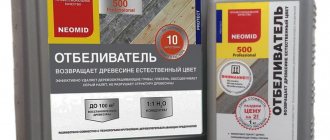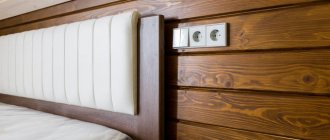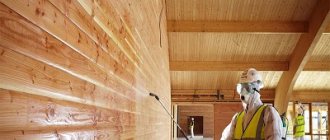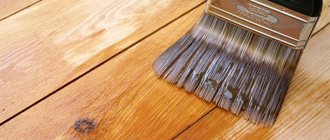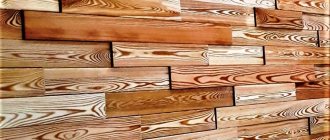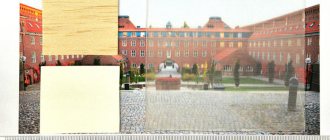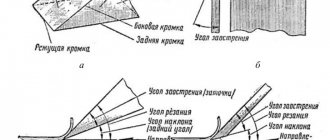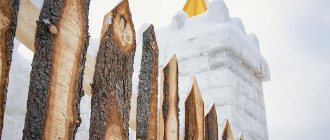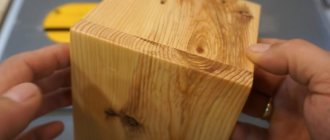In accordance with current fire safety standards and regulations, fireproofing of wooden structures at facilities for any purpose: residential, civil and industrial. This measure is part of a set of necessary actions to ensure fire safety of people and property. If previously the requirement applied only to large buildings and structures, now it also applies to private houses. Without such treatment, buildings cannot be put into operation after construction, or decommissioned by the commissions of the Ministry of Emergency Situations. Such measures were taken to reduce the number of fires.
What is fire retardant treatment of building structures?
Treating wooden structures with a fire retardant compound is a measure that reduces the flammability of materials. Activities include:
- creation of non-combustible cladding coatings for building structures using fire-fighting materials;
- coating wooden elements and parts made of other materials with protective compounds;
- increasing the fire resistance properties of buildings and structures through refurbishment or reconstruction.
The decision to use protective compounds, in accordance with GOST and SNiP, is made at the design stage. Upon completion of construction, fire protection is also checked upon acceptance of the facility.
Important! During the operation of the building, fire retardant treatment of wooden structures is checked at certain intervals. Control of buildings where large numbers of people often gather is carried out according to an approved schedule.
Protection of the rafter system from fires
How to choose a fire retardant for wood. A Guide to Modern Fire Retardants
We will talk mainly about impregnations. They are used much more often than varnishes or paints, and working with them usually raises more questions. The most important recommendation in this regard is extremely obvious - carefully read the instructions on the package. Even better if this is detailed documentation for the product. Methods for preparing the working solution, requirements for surface treatment, the recommended number of layers to be applied, calculation of consumption per m2 and much other important information, including safety precautions, will be indicated here.
Fire retardants are applied using a roller, a brush with synthetic bristles, or by spraying. Since finished structures are almost always processed, these methods are the most practical. As a rule, the solution is applied in two to four layers, with or without intermediate drying (this point will definitely be indicated in the product instructions).
Along with surface treatment, the immersion method is also worth mentioning. It ensures deeper penetration of the solution into the wood structure and, importantly, uniform treatment of the structure over the entire surface. The disadvantages of this method are also quite obvious - a large one-time consumption of fire retardant and difficulties in preparing the container for soaking, since in 90% of cases we are talking about long wooden structures.
Processing rules and common mistakes
Applying the composition to raw wood The humidity of wooden structures should be no more than 15%. The raw material does not absorb the solution well, which makes it impossible to achieve the declared fire-retardant efficiency group.
Subsequent mechanical treatment Fire retardant treatment using non-industrial methods ensures that fire retardants penetrate only a few millimeters into the thickness of the wood. Subsequent grinding, planing and other mechanical processing methods partially or completely reduce the fire protection effect.
Poor surface preparation Before applying impregnation, wooden surfaces are cleaned of dust and dirt. Particular attention is paid to oil and bitumen stains. If there are any, the area of contamination is planed or sanded. Otherwise, the fire retardant will not be able to properly penetrate the wood structure.
Processing wood with a high resin content Resin content also affects the penetration depth of solutions. For critical structures, they try not to use such wood - they purchase it in a deresined form or carry out this procedure independently. It is also advisable to consider more expensive film coatings rather than impregnations for structures with a high resin content.
Processing at low temperatures The permissible temperature limit for applying most fire retardants is not lower than + 5°C. However, there is a small segment of products designed for use at lower temperatures. If possible, this practice should be abandoned (if we are talking about impregnations). No matter what advanced chemical formula the composition has, its application at sub-zero temperatures will be less effective. This is because frozen moisture in the wood's capillaries prevents proper absorption.
Exposure to direct sunlight In this case, the impregnation process is disrupted due to rapid surface evaporation of the composition. The active components of antipyrine do not have time to penetrate into the thickness of the wood and remain on the surface.
Gaps and uneven surface treatment Control of gaps and sagging is a typical problem inherent in all colorless impregnations. If desired, this can be solved by adding special tinting indicators to the solution. For tinting colorless impregnations, use only those dyes recommended by the manufacturer. Many formulations are offered with a color indicator already added.
Inadequate treatment of joints and hard-to-reach places This problem occurs very often, since, as a rule, already assembled structures are treated with fire retardants. It can be difficult to get to some places with a brush or roller, so the most effective application method in this case is spraying.
Use of incompatible coatings Structures impregnated with fire retardants are sometimes additionally coated with paint. This is done mainly with street structures to prevent premature leaching of fire protection components. But you should know that many salt impregnations are incompatible with other formulations, so it is important to carefully read the instructions and clarify this point in advance.
Treatment of affected surfaces Wooden structures with traces of fungal infections are pre-bleached: the source of biological activity is eliminated and the natural color is returned to the wood. For more information about how and what is the best way to do this, read a separate article:
- All the most important things about wood bleaching
Overheating the solution To improve absorption, some formulations recommend heating to 50-60°C. You should be especially careful here, because... Overheating of the product may result in deterioration of its fire retardant properties.
Neglecting protection from water After treating street structures, the wood must be protected from exposure to precipitation for an average of 48 hours.
Who can do the work
You can apply coatings to wood structures of a private house yourself, but the fire protection inspection is carried out by a licensed Ministry of Emergency Situations employee. You can order an independent examination; in this case, the quality of the coatings is checked by specialized companies that have certificates and approvals. In multi-apartment residential buildings, administrative, industrial and social buildings, it is advisable to use the professional services of enterprises specializing in this type of work, whose employees provide training. They can perform audits, carry out design, and prepare estimates. Their work is certified and will not raise additional questions for firefighters. The purchase of special compounds can be carried out by the owners of the facilities themselves, but they must be guided by the OKPD.
Coating wooden parts with fire retardant compounds before use
Norms and rules of work
To ensure that checking the state of fire retardant treatment does not become a problem, the work must be carried out in accordance with the standards established in the Russian Federation. All rules and requirements are formulated:
- Decree of the Government of Russia No. 390 of 2012;
- GOST R 53292.2009;
- Russian Government Decree No. 113 of 2014.
How often the state of fire retardant treatment should be checked is regulated by state regulations. Quality is controlled according to established methods at least once a year. Or in accordance with the warranty period of the composition specified in the accompanying documents by the manufacturer.
On a note! The result of the measures is a conclusion from the Ministry of Emergency Situations laboratory. It indicates the materials used, their quality, date of research, performers, name of the organization that performed the work, license number of the Ministry of Emergency Situations and conclusions.
Treatment of buildings on a summer cottage with a special composition
What buildings and structures require fire protection?
According to the norms and rules, treatment with special compounds must be carried out in any buildings where there are wooden structures. Coatings are applied to ventilation and air conditioning ducts, to wood roofing elements, including attics, fabrics, metal parts, to fire damper housings and other structural parts of premises. Increased attention should be paid to objects of category 1 - educational and medical institutions: hospitals, schools, kindergartens, clinics.
- 1 group of wood does not need treatment;
- Groups 2 and 3 – must be covered with compounds.
Also, high demands are placed on places where people gather: shopping centers, restaurants, cafes, cinemas, theaters.
Impregnation of corner joints of a timber house with a fire retardant compound
Cost of impregnation of wooden structures
The cost of processing consists of several components:
- material price;
- price of work – depends on volume and complexity;
- delivery price depends on the distance of the object.
Approximate cost of impregnation of wooden structures
| Work performed | Price |
| Application of fire retardant up to fire resistance limit R30 | from 650 rub/m2 |
| Application of fire retardant up to fire resistance limit R60 | from 900 rub/m2 |
| Application of fire retardant up to fire resistance limit R90 | from 1200 rub/m2 |
| Application of fire retardant up to fire resistance limit R120 | from 1600 rub/m2 |
| Impregnation with a fire retardant composition up to efficiency group 1 (obtaining wood that is difficult to burn) | from 70 rub/m2 |
| Impregnation with a fire retardant composition up to efficiency group 2 (obtaining fire-resistant wood) | from 100 rub/m2 |
| Application of fire retardant paint up to R30 | from 200 rub/m2 |
| Application of fire retardant paint up to R60 | from 250 rub/m2 |
| Application of fire retardant paint up to R90 | from 300 rub/m2 |
| Application of fire retardant paint up to R120 | from 400 rub/m2 |
| Coating with fire retardant varnish up to group 1 | from 350 rub/m2 |
| Coating with fire retardant varnish up to group 2 | from 500 rub/m2 |
Our specialist will answer you in more detail, call: 8 (495) 150-5-987
IMPREGNATION
How the work is carried out
Fire retardant treatment of wooden structures includes the following operations:
- applying protective compounds to structures: impregnations, paints, varnishes or mastics;
- checking the quality of fire retardant treatment;
- preparation of documents based on the results of the inspection.
All responsibility for the work and its quality falls on the owner of the building, therefore, in order to avoid questions from supervisory authorities, it is advisable to use the services of professionals. They will be able to conduct an audit of premises and buildings, select adequate materials for a specific facility, calculate surface areas and volumes of protective compounds, and determine the optimal technology for performing the work. The customer will only have to sign the estimate and contract, wait for the work to be completed and receive a full package of documents. Having such significant evidence in hand, the owner is guaranteed to be free from claims from inspection authorities.
Processing a finished log house
Other
In addition to fire-retardant impregnation, we carry out other types of fire-resistant wood treatment: paint coating, lining with fire-resistant materials. You can also order fire retardant treatment of other materials and structures from us:
- reinforced concrete floors, columns, walls;
- metal columns, stairs, structural and decorative elements made of metal;
- textile surfaces - carpets, suspended ceilings, etc.;
- cable networks, electrical wiring;
- air ducts, climate systems.
We carry out installation of fire alarms and installation of fire-resistant windows, stained glass windows, and doors.
Test results
After the work is completed, the quality of fire retardant treatment is checked. The results are recorded in a document - an act. It is drawn up in the presence of an employee of the Ministry of Emergency Situations and a responsible representative of the facility. The check itself is carried out as follows:
- visual inspection of wooden structures;
- quality control of the protective layer;
- identification of areas left without coverage;
- samples are collected;
- samples are tested by fire using a special device for a specified time.
The document has a special form, but is filled out randomly, according to the identified situation. If such a document is not submitted to the commission that carries out planned supervisory activities, this will raise many questions for the owner of the property. Acts are drawn up after each inspection. Responsibility for fire protection lies with the manager of the enterprise, so he must carry out the entire range of measures.
A protocol drawn up after testing the quality of fire protection of wooden structures of a building
Frequency of work
Any fire retardant coating has its own validity period, during which it retains its properties. As time passes, the effectiveness of the qualities decreases, and wooden and metal structures again become vulnerable to fire. Therefore, after the expiration of the period, the surfaces must be re-coated with compounds. According to regulatory requirements, work is performed at a certain frequency. The time during which the compositions retain their qualities is indicated in the documentation:
- funds have different terms depending on the type and purpose, but not more than 10 years;
- compositions for metal structures – up to 20 years;
- If the documentation does not indicate the timing, then re-coating must be carried out once a year.
This requirement is established by the Decree of the Russian Government. Re-application of the protective material is carried out if damage is detected during the quality check of the fire retardant treatment. Violations of this regulation are fraught with sanctions from inspection authorities, up to and including decommissioning of the facility.
Video:
Fire impregnation for wood - the best option for fire protection of wood
In addition to fire-retardant impregnation of wood, there are other options for fire-fighting treatment: paints and varnishes, coating pastes, cladding with fire-fighting materials. But all these types of protection are superficial.
If the fire has already penetrated the structure, they can prevent the spread of open flames, but will not protect the structure itself from destruction.
Fire retardant impregnation of wooden structures is much more effective in this regard.
Important!
Impregnating compounds penetrate into the thickness of wood to a certain depth (depending on the specific impregnation agent and technology). As a result, the material itself becomes non-flammable, and not just its protected surface.
In addition, many compositions additionally contain components that improve the performance properties of wood. The most common option is fire-bioprotective impregnation for wood: it contains an antiseptic component, thanks to which the material is protected not only from fire, but also from biological factors (fungus, wood-boring insects, etc.)
is a certified dealer of the best domestic and foreign manufacturers of fireproof materials.

